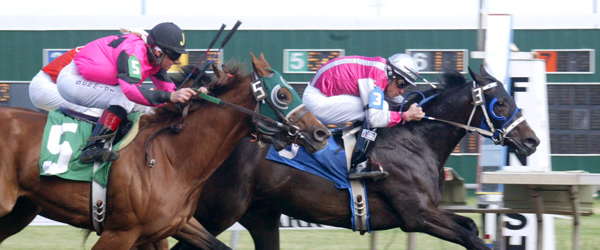 Springtime at the track assures one thing: two-year-old maidens abound. Though the AQHA and its regional affiliates promote racing for horses of all ages and often incentivize racing for older horses, the speed with which quarter horses mature and the money and prestigious races available enable many horses’ racing careers to begin early in their two-year-old year.
Springtime at the track assures one thing: two-year-old maidens abound. Though the AQHA and its regional affiliates promote racing for horses of all ages and often incentivize racing for older horses, the speed with which quarter horses mature and the money and prestigious races available enable many horses’ racing careers to begin early in their two-year-old year.
Handicapping two-year-old races is challenging because the unpredictable nature of young horses can make the outcome difficult to predict. Coupled with lack of experience from the maiden entries, the empty running lines of first-time starters makes the task of picking a winner even more daunting. However, there are several angles you can apply to narrow down the field:
Workouts vs Training Races
Workouts are one of the least important pieces of information to use when handicapping first time starters, unless you are able to witness them in person. Tracks have dedicated clockers and staff to follow horses and their workouts, but accurate times may not tell the whole story. We cannot know who the horse worked against, if it was pushed or held back, the horse’s regular exercise routine, or the trainer’s intent for the work. The most useful information is whether or not the workouts are from a gate, as that is what can cause the most problems for a first-time starter.
Training races, on the other hand, can provide insight into a horse’s ability to perform under racing conditions. These are dress rehearsals for a race, with a full field loaded into a gate and electronically timed for a set distance. The races are logged by number and day, so you can see how a horse performed compared to other horses in the training race. In some cases, you can view the race replays. Though training races are growing in popularity, they are currently only found at handful of tracks, such as Remington Park in Oklahoma City. In your Racing Form, a training race will be abbreviated in the workout line as TR.
Breeding
Examining pedigrees of first-time starters can identify talent, but it takes time to learn what to look for in a horse’s breeding. Fortunately, there are shortcuts. Quarter horse websites provide lists of leading sires ranked by money earned, number of starters and number of wins. The American Quarter Horse Association keeps statistics here and stallionesearch is another good resource. For example, as of this week, Ivory James is the leading sire of two-year-olds by number of winning starters and Pyc Paint Your Wagon is the leading sire by total earnings of two-year-olds.
First-Time Starters vs More Experienced Maidens
In a field of predominantly first-time starters, a horse that has already raced may have an advantage over the field. But there are some things to keep in mind. First, check the trainer stats. Some trainers are particularly good with horses making their debut; others excel with horses making their second start. Don’t dismiss a horse’s performance (or lack thereof) until you understand the trainer’s strengths. Next, look at the type of races involved. If a horse was making its debut in a trial race and ran poorly, it may have run because it was paid into the race and it was worth it to attempt to qualify, not because it was an optimal time for the horse to enter a race. If the current race is a trial, keep this in mind as you sort through the first time starters; in this case, it may make sense to consider the horses that have already raced. Finally, consider where the horses competed in their previous starts. A horse that did not impress in his debut at Ruidoso may crush the field in his next out at SunRay. Horses that have been competing at tracks such as Ruidoso, Remington, Sunland or Prairie Meadows has likely been facing tougher company than other tracks. Check out some more hints in the video below:
[youtube http://www.youtube.com/watch?v=arUGYei4H-g?rel=0]
Since this is only the second week in of the quarter horse meet at Canterbury, most of the horses we will see have been racing at other tracks. Below is an abbreviated list of tracks that should appear most frequently in the running lines of American Quarter Horses at Canterbury Park:
ARP – Arapahoe Park, Aurora, CO
BCF – Brown County Fair, Aberdeen, SD
BEU – Beulah Park, Grove City, OH
CPW – Chippewa Downs, Belcourt, ND
DED – Delta Downs, Vinton, LA
FAR – North Dakota Horse Park, Fargo, ND
FMT – Fair Meadows at Tulsa, Tulsa, OK
FP – Fairmount Park, Collinsville, IL
FTP – Ft Pierre Horse Racing, Fort Pierre, SD
GIL – Gillespie County Fair, Fredericksburg, TX
HOO – Hoosier Park, Anderson, IN
HOU – Sam Houston Race Park, Houston, TX
IND – Indiana Downs, Shelbyville, IN
LAD – Louisiana Downs, Bossier City, LA
LS – Lone Star Park, Grand Prairie, TX
PRM – Prairie Meadows, Altoona, IA
RET – Retama Park, San Antonio, TX
RIL – Rillito Park, Tucson, AZ
RP – Remington Park, Oklahoma City, OK
RUI – Ruidoso Downs, Ruidoso Downs, NM
TUP – Turf Paradise, Phoenix, AZ
WRD – Will Rogers Downs, Claremore, OK
This blog was written by AQHA Q-Racing Ace Jen Perkins. Jen travels to tracks across the country to educate fans about handicapping and Quarter Horse racing, and will share her perspective on Canterbury Quarter Horse racing as well as insider information on America’s fastest athletes.